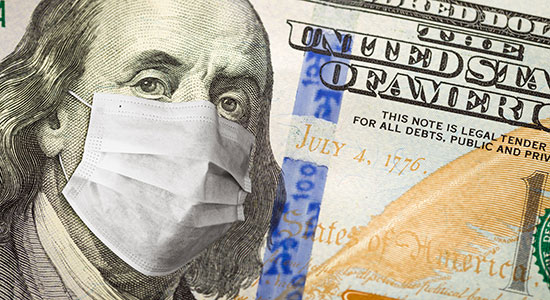
Jan. 6, 2021 – President Donald Trump on Dec. 27 signed into law a government funding and appropriations bill that includes several coronavirus response and relief provisions, including another round of Paycheck Protection Program (PPP) funding.
The law also includes a stimulus package and continued unemployment benefits, funding for schools and day cares, and extension of an eviction moratorium.
Stimulus Payments
Individuals making less than $75,000 per year, based on their 2019 tax return, will receive $600, including $600 per dependent child. Just as with the previous stimulus payment, the benefit decreases $5 for every $100 earned over the $75,000.
 Jessica M. Kramer, U.W. 2004, is a partner at Kramer, Elkins & Watt, LLC in Madison, focusing on employment and landlord-tenant matters, and civil litigation. Reach her by email or by phone at (608) 709-7115.
Jessica M. Kramer, U.W. 2004, is a partner at Kramer, Elkins & Watt, LLC in Madison, focusing on employment and landlord-tenant matters, and civil litigation. Reach her by email or by phone at (608) 709-7115.
 Joe Andreoni, U.W. 2016, is an associate at Kramer, Elkins & Watt, LLC. He also concentrates his practice on employment and landlord-tenant matters, and civil litigation.
Joe Andreoni, U.W. 2016, is an associate at Kramer, Elkins & Watt, LLC. He also concentrates his practice on employment and landlord-tenant matters, and civil litigation.
Therefore, individuals who earn approximately $87,000 will not see any payment. Joint filers making less than $150,000 will receive $1,200.
Unemployment Insurance Benefits
The bill also extends and modifies the Coronavirus Aid, relief, and Economic Security (CARES) Act’s unemployment provisions (you can find our analysis of those provisions here), through the end of March 2021.
The Pandemic Unemployment Assistance (PUA) and Pandemic Emergency Unemployment Compensation (PEUC) eligibility criteria remain the same, except that state agencies are now specifically empowered to request documentary proof of employment (or prospective employment) from applicants who have had to quit their jobs or are unable to reach their jobs due to COVID-19.
The federal Pandemic Unemployment Compensation (FPUC) additional payments that ran through the end of July 2020 are renewed between January and March, but at the rate of $300 per week (in addition to state benefits), instead of the previous $600.
Paycheck Protection Program
The legislation revamps the PPP, which allows employers to take out loans that are forgiven if the funds are used to retain and pay employees. With respect to PPP, the bill also provides the following details:
-
It appears that entities that were previously eligible for the PPP, but did not receive funds, are still eligible under the guidelines for eligibility for the original PPP, set forth under the CARES Act, such as having 500 or fewer employees.
-
Creating a “second draw” for entities that received a PPP loan in 2020 to take out a second loan.
-
Expanded eligibility, allowing nonprofits and local news media to benefit from the PPP and sets aside money specifically for theaters, live entertainment venues, and cultural institutions or museums.
-
Loans can now be used to cover costs incurred by teleworking, equipment needed to comply with social distancing or necessary sanitation, and repairing property damage that occurred during public disturbances throughout 2020 even if it does not directly relate to retaining employees.
Entities applying for a “second draw” loan face additional limiting criteria:
-
Loans are capped at $2 million dollars, whereas first-time applicants can receive $10 million. At least 60 percent of the loan amount must still be used for payroll, with the remainder used for eligible expenses like rent or utilities (this has not changed from the original PPP criteria).
-
Applicants must be entities with less than 300 employees.
-
Applicants must, in comparing any quarter of 2020 to the same quarter of 2019, have suffered a 25 percent decline in quarterly revenue.
-
Applicants can not engage in substantial political or lobbying activity or have substantial ties to China, such as a board member who lives in China.
-
Size limits apply to some organizations specifically made eligible for PPP loans and borrowing for the first time: Housing cooperatives and 501(c)(6) organizations are only eligible with less than 300 employees. News and media organizations are eligible if have less than 500 employees.
-
Applications will be accepted until March 31, so long as funds last.
The bill makes an important change from a taxability standpoint: PPP funds, including those already used in 2020, will not be taxable income for the businesses that received the funds, and the businesses will be able to deduct the expenses for which the funds were used just as they would normally deduct such expenses (e.g., payroll).
Eviction Moratorium Extended
The bill extends the current eviction moratorium, initiated by order of the Centers for Disease Control and Prevention (CDC) in September.
The CDC moratorium prevents eviction based on nonpayment of rent of tenants who make certain declarations. The moratorium, originally set to expire at the end of the year, now goes through January 31, 2021.
Other Items Funded
The new legislation sets aside $25 billion to be disbursed as rental aid and allows landlords to assist their tenants in applying for the aid. Eligible tenants can receive assistance up to the amount of 12 months’ rent.
The bill bolsters funding for the purchase and distribution of COVID-19 vaccines and testing, the Supplemental Nutrition Assistance Program (SNAP).
The Department of Education also receives almost $82 billion, available through the end of September 2022 to disburse to schools to “prevent, prepare for, and respond to” COVID-19. This aid is available, in varying degrees, to K-12 schools as well as colleges and universities, both public and private.
The law provides for financial assistance to childcare centers, transportation-related entities such as airlines, and to farmers through the Coronavirus Food Assistance Program.
Benefits Not Extended in the Legislation
One notable omission from this bill, as compared to previous legislation and executive actions, is any discussion of student loans.
Pursuant to the CARES Act and executive orders issued earlier in the year, collection of federal student loans, and accrual of interest on the same, was temporarily halted until the end of January 2021. This new legislation does not address student loans. This means that, absent any other action, loan payments will come due again in February.
The bill also largely omits the emergency paid sick leave and emergency FMLA mandated by the Families First Coronavirus Response Act (FFCRA) passed in Spring of 2020 (you can review our summary of that legislation here).
Under the FFCRA, employees were able to take up to two weeks sick leave and an additional 10 weeks of paid, job-protected leave if they were affected by COVID-19 in an enumerated list of ways. That sick leave was paid for by a tax credit for employers, making it budget-neutral for employers. This entitlement ended December 31, 2020 and is not extended or renewed by the new legislation.
The new legislation does, however, extend the tax credit reimbursement to the end of March 2021, providing reimbursement for employers who wish to provide the paid sick leave to employees who did not receive it in 2020, though they are not required to do so. Essentially, employers now have the option to provide the emergency sick leave or extended FMLA; it is no longer mandatory.
Employers who want the tax credits must abide by the FFCRA provisions pertaining to job protection and anti-discrimination. However, the bill does not renew the two weeks’ sick leave or 10 weeks emergency FMLA for employees who have already used it.
